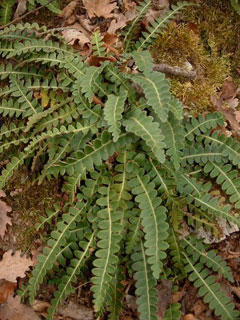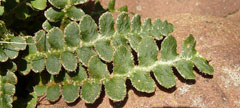 |
|
http://commons.wikimedia.org/wiki/User:Rasbak |
 |
| http://commons.wikimedia.org/wiki/User:BerndH |
Translate this page:
Summary
Physical Characteristics

 Asplenium ceterach is a FERN growing to 0.2 m (0ft 8in) at a medium rate.
Asplenium ceterach is a FERN growing to 0.2 m (0ft 8in) at a medium rate.
See above for USDA hardiness. It is hardy to UK zone 8. The seeds ripen from April to October. The plant is not self-fertile.
It is noted for attracting wildlife.
Suitable for: light (sandy) and medium (loamy) soils and prefers well-drained soil. Suitable pH: basic (mildly alkaline) soils and can grow in very alkaline soils.
It can grow in full shade (deep woodland) semi-shade (light woodland) or no shade. It prefers moist soil.
UK Hardiness Map
US Hardiness Map
Synonyms
Ceterach officinarum. DC.
Plant Habitats
Woodland Garden Dappled Shade; Shady Edge; North Wall. In. East Wall. In. West Wall. In.
Edible Uses
References More on Edible Uses
Medicinal Uses
Plants For A Future can not take any responsibility for any adverse effects from the use of plants. Always seek advice from a professional before using a plant medicinally.
Antitussive Diuretic
The whole plant is antitussive and diuretic[7]. It is widely used in the Mediterranean to treat gravel in the urine and is also used with other mucilaginous plants to treat bronchial complaints[7]. The taste is very bitter and needs to be sweetened with other herbs such as liquorice[7]. The plant is harvested from late spring to summer and can be dried for later use[7]. Some caution should be employed in its use since it has not been fully tested[7].
References More on Medicinal Uses
The Bookshop: Edible Plant Books
Our Latest books on Perennial Plants For Food Forests and Permaculture Gardens in paperback or digital formats.

Edible Tropical Plants
Food Forest Plants for Hotter Conditions: 250+ Plants For Tropical Food Forests & Permaculture Gardens.
More

Edible Temperate Plants
Plants for Your Food Forest: 500 Plants for Temperate Food Forests & Permaculture Gardens.
More

More Books
PFAF have eight books available in paperback and digital formats. Browse the shop for more information.
Shop Now
Other Uses
Spleenworts can be utilized as ground cover in shaded areas, helping to stabilize soil and prevent erosion. They are also beneficial in enhancing biodiversity within shaded forest gardens. 1. Nectary - Flowers rich in nectar and pollen:
No – Spleenworts do not produce flowers; they reproduce via spores.
2. Wildlife - Food (Fruit, Seeds, Leaf litter, Shelter, Nesting, Roosting):
Yes – While not commonly consumed by humans, some species of spleenworts can be a food source for herbivorous insects. The dense foliage can provide shelter for small animals, although they are not typically used for nesting.
3. Invertebrate Shelter (Overwintering sites, Leaf litter, Groundcover):
Yes – The fronds and leaf litter from spleenworts can provide habitat and shelter for invertebrates, as well as serve as overwintering sites.
4. Pest Confuser (Smell):
No – Spleenworts do not have notable aromatic properties that would help confuse pests.
Special Uses
References More on Other Uses
Cultivation details
A calcicole plant, it requires a freely draining but moist alkaline soil[1]. It tolerates full sun but prefers a position with at least part-day shade[200] and also grows in deep shade[219]. Plants can be grown in old brick walls[219]. A very ornamental plant[1]. Members of this genus are rarely if ever troubled by browsing deer[233]. Spleenworts have a slow to moderate growth rate, depending on the species and environmental conditions. They thrive in moist, shaded habitats.
References Carbon Farming Information and Carbon Sequestration Information
Temperature Converter
Type a value in the Celsius field to convert the value to Fahrenheit:
Fahrenheit:
The PFAF Bookshop
Plants For A Future have a number of books available in paperback and digital form. Book titles include Edible Plants, Edible Perennials, Edible Trees,Edible Shrubs, Woodland Gardening, and Temperate Food Forest Plants. Our new book is Food Forest Plants For Hotter Conditions (Tropical and Sub-Tropical).
Shop Now
Plant Propagation
Spores - best sown as soon as they are ripe on the surface of a humus-rich sterilized soil. Keep the compost moist, preferably by putting a plastic bag over the pot. Germinates in spring[1]. Spring sown spores germinate in 1 - 3 months at 15°c[134]. Pot on small clumps of plantlets as soon as they are large enough to handle and grow them on in light shade in a cold frame or greenhouse. Keep them humid until they are well established. When they are at least 15cm tall, plant them out into their permanent positions in late spring or early summer.
Other Names
If available other names are mentioned here
Native Range
TEMPERATE ASIA: Cyprus, Egypt (Sinai), Iran, Israel, Jordan, Lebanon, Syria, Turkey, Russian Federation-Ciscaucasia (Ciscaucasia), Armenia, Azerbaijan, Georgia, Kazakhstan, Kyrgyzstan, Tajikistan, Uzbekistan TROPICAL ASIA: Pakistan EUROPE: United Kingdom, Ireland, Austria, Belgium, Switzerland, Czech Republic, Germany, Hungary, Netherlands, Poland, Slovakia, Ukraine (incl. Krym), Albania, Bulgaria, Bosnia and Herzegovina, Greece (incl. Crete & e. Aegean Islands), Croatia, Italy (incl. Sardinia, Sicily), North Macedonia, Montenegro, Romania, Serbia, Slovenia, Spain, France, Portugal AFRICA: Spain (Canarias), Portugal (Madeira Islands), Algeria, Egypt, Libya, Morocco, Tunisia
Weed Potential
Right plant wrong place. We are currently updating this section.
Please note that a plant may be invasive in one area but may not in your area so it's worth checking.
Conservation Status
IUCN Red List of Threatened Plants Status :

| Related Plants
|
| Latin Name | Common Name | Habit | Height | Hardiness | Growth | Soil | Shade | Moisture | Edible | Medicinal | Other |
| Asplenium adiantum-nigrum | Black Spleenwort | Fern | 0.5 |
5-9
| | LM | FS | M | 0 | 2 | 2 |
| Asplenium bulbiferum | Hen And Chicken Fern, Parsley Fern, Mother Spleenwort | Fern | 0.3 |
10-11
| S | LMH | SN | M | 1 | 0 | |
| Asplenium ruta-muraria | Wall Rue, Lance asplenium | Fern | 0.1 |
5-9
| S | LM | S | M | 0 | 2 | |
| Asplenium scolopendrium | Hart's Tongue Fern | Fern | 0.6 |
4-8
| S | LM | FS | DM | 0 | 2 | 3 |
| Asplenium trichomanes | Maidenhair Spleenwort, Dense spleenwort, Toothed spleenwort, Brightgreen spleenwort | Fern | 0.4 |
5-9
| M | LM | FS | M | 1 | 1 | 2 |
| Athyrium filix-femina | Lady Fern, Common ladyfern, Subarctic ladyfern, Asplenium ladyfern, Southern Lady Fern, Tatting Fer | Fern | 0.6 |
3-8
| M | LMH | FS | M | 1 | 2 | 2 |
|
Growth: S = slow M = medium F = fast. Soil: L = light (sandy) M = medium H = heavy (clay). pH: A = acid N = neutral B = basic (alkaline). Shade: F = full shade S = semi-shade N = no shade. Moisture: D = dry M = Moist We = wet Wa = water.
Now available:
Food Forest Plants for Mediterranean Conditions
350+ Perennial Plants For Mediterranean and Drier Food Forests and Permaculture Gardens.
[Paperback and eBook]
This is the third in Plants For A Future's series of plant guides for food forests tailored to
specific climate zones. Following volumes on temperate and tropical ecosystems, this book focuses
on species suited to Mediterranean conditions—regions with hot, dry summers and cool, wet winters,
often facing the added challenge of climate change.
Read More
Expert comment
Author
L.
Botanical References
17200
Links / References
For a list of references used on this page please go here
Readers comment